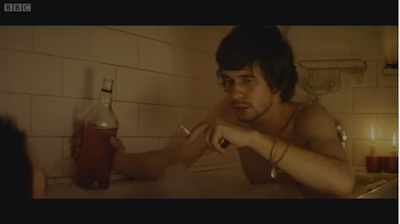Love Hate (2009)
Contextual Research - Short Film
Love Hate is
a dark comedy short film, focusing around two juxtaposing characters. Tom, a
kind-hearted yet meek charity worker is one day followed home by a mysterious and
beguiling woman. After inviting herself in, Tom realises that he has set
himself up for a relationship from hell, as she reveals herself as his “Hate.”
Over time, the pair bond over violence and loathing as hate gradually takes over
Tom’s life. When he inevitably falls in love with Hate, he embarks on a self-destruct
mission, isolating himself from every friend he once had. Things suddenly take a
turn when Tom is forced to tackle “self-hate”, at which point he decides that
the relationship “isn’t working.” The end of the film sees Tom in a seemingly
much happier place, reunited with his ex, aptly named Joy. However, we soon discover that
he and Hate are expecting their own child, creating an excellent cliffhanger.
One of the things that really stuck out to me in the film is the fact that it is completely centered around two completely opposite characters. The story itself comes from character development, meaning that strong personalities are needed to carry the narrative and engage an audience. The writing and portrayal of these characters is therefore complex yet believable. Even tiny mannerisms add detail to the characters, things such as a facial expression or body movement, could potentially be missable - for example:
 |
| Tom trips his elbow over the fireplace, shows that he is insecure / not confident within his own movements; perhaps putting on a front of confidence. |
 I have tried to employ this same detail into my own characters, Adam and Eve, through my writing process - making it clear even at this initial writing stage the exact way I wish my lines to be delivered (even if it is more for a note to me as director rather than my actors).
I have tried to employ this same detail into my own characters, Adam and Eve, through my writing process - making it clear even at this initial writing stage the exact way I wish my lines to be delivered (even if it is more for a note to me as director rather than my actors).Similarly, I have also started to develop storyboards for my shots, depicting the style of my film, and how my characters will be portrayed within it. Blake and Dylan Ritson, the writers and directors of Love Hate have used specific camera angles and mise-en-scene to enhance character, including:
 |
| Low Angle shot of Hate, dressed in dark clothing - symbolising her dark and domineering role within the narrative. |
Here, the film’s visual representation of Tom's destructive urges is evident. John Lynch’s cinematography creates a gloomy and malicious rendering of Tom’s powerful Hate. The darkened and dimly-lit interiors capture the increasingly gloomy nature of his deeply immoral actions. The cloudy skies in the exterior shots which are so characteristic of Britain, effectively demonstrate the darkness and explosion of Tom’s inner turmoil that’s lurking just above him.
Again, this attention to detail is something I would like to consider in my own film. I plan to film at night to emphasise the dark themes explored in my story, and as the narrative resolves, it is reflected by the approaching daylight - restoring balance and clarity to the situation. I would also like to visually represent my character's confusion and disorientation by using low-key lighting, hopefully using mainly natural light and streetlamps to imply Adam and Eve's inability to see their way out of the dark situation they find themselves in - as well as making the most of my location.





No comments:
Post a Comment